Talk about a service life, 34 years!
I bought my new water heater, along with the gas line conversion kit (Basically the right length of flexible gas line and a 90 degree brass elbow to attach it to the original water heater connection ), and the flush water heater door. I also picked up a tube of ProFlex, and a roll of buytl tape both of which I used the majority of up installing the water heater. I also picked up a can of injection foam to fill in around the water heater to give it a good air/water tight seal.
Here you can see the old water heater sitting next to its replacement:
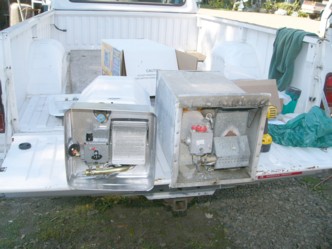
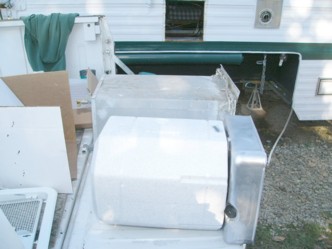
The old water heater was housed in a sheet metal box, the sides of which were stapled along the edges and the back. As far as I can tell, its made out of wood. The water heater itself is in the center wrapped in some kind of white insulation that looks a bit like fiberglass. I didn't open it up to look, as I have a sneaking suspicion that it may be Asbestos-based insulation. I had long ago filled in all the openings in the sheet metal housing with expanding foam to prevent any dust or fume leakage.
Here's the opening it came out of:
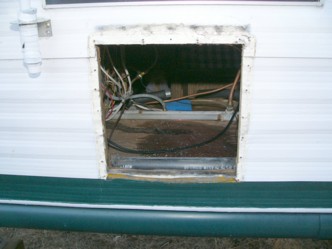
A little closer inspection revealed (The water on the bottom of the compartment is runoff from when I unhooked the plumbing):
That the little 1x2 that sits underneath the edge of the water heater had begun to dry rot. Fortunately, its not structural, its just stapled in between the bigger 1x4s that are on either side that run along the top of the wing. All it does is support the edge of the water heater.
Since I didn't have anything to replace it with, or the time to do it, I packed it in a bed of butyl tape and sealed the laps in the siding to prevent any further water damage. The wood on either side and below it are fine and the water damage doesn't extend past the one 1x2 that was directly under the water heater. Odds are this was caused by water wicking back from the bottom edge of the water heater compartment, the water heater didn't have any caulking around it when I bought the camper, and I sealed it up at that point. Since the wood was dry when I checked it, I'd wager the water penetration had been stopped at that time and had progressed no further.
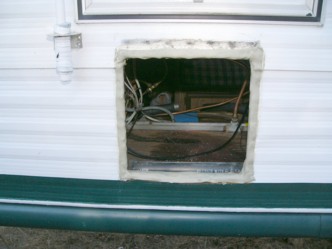
Since the water heater really didn't have any particular screw-down-here spots on it, I drove some two inch screws into the vertical members running on either side of the water heater to secure it in place. These I had salvaged from the removal of the original water heater and were still in good condition.
Unlike the Radius edged door you can get for this water heater, the Flush mount has no screws that actually drive into the sides of the camper. It has several screws on the inside that screw into the water heater itself and suck the face plate down. To make certain it was sealed tight, I put a double bead of proflex around the flange that slides into the water heater itself and put a thick coat of butyl tape along the edges of the door assembly. The caulk on the flange will seal the door to the water heater to prevent water from wicking between the two. Once the face plate was sucked down, I caulked around the door frame and sealed her up tight to the camper.
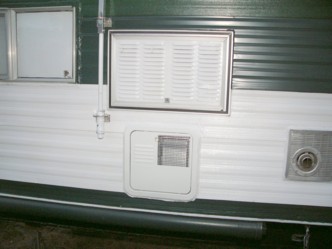
A couple of quick shots of spray paint, and the water heater install is done.

Thanks for reading!



Nice job! Looks like a quality job that I would lay odds are better than you would have gotten at an RV repair shop, trust me on this one!
ReplyDeleteErik
I've since actually pulled that water heater again. The wooden wall structure underneath it was water damaged at the time I did this swap, but I didn't have the resources to repair it.
ReplyDeleteI've since treated the wall with Minwax Wood Hardener, and sistered in some new 1x4 material to strengthen the opening. I also built a better fitting platform for the water heater to rest on and anchored it in place.
I then switched to the face plate with the swing down door that actually anchors into the outside of the RV.
The original one shown is held in place by compression from the water heater and it didn't take long for the natural flexation of the camper to pop most of the caulking seams along the edge.
Good thing you do most of the things rightly. That's all hard for me.
ReplyDelete